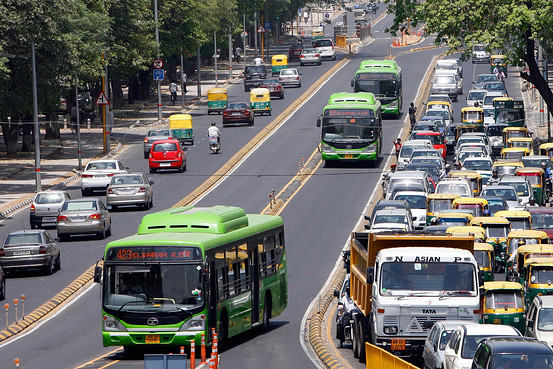India: India Transportation Profile
2016/12/04

Surface transportation infrastructure includes roads, ports, and railways. India’s road network covers nearly 3 million kilometers, and is the third largest in the world. The National Highways are the prime road network in India and cater to 45% of the total road transport demand. This report covers the industry.
India’s transportation sector is large and diverse; it caters to the needs of 1.2 billion people. The Indian transportation & logistics sector is increasingly attractive to foreign and domestic operators as well as strategic and financial investors. There is an urgent need for capital investment in India’s infrastructure and improve the county’s roads, ports, airports, power plants, transportation systems, warehousing, cold chains, etc.
Freight rates for 10 tonne load surged by Rs 1,000 in the local truck transport market today following thin availability of trucks against increased cargo movements.
Transporters said less position of trucks and better movement of cargo mainly pushed up freight rates.
Delhi to Bangalore, Coimbatore and Kochi rates moved up by Rs 1,000 each to Rs 58,000, Rs 63,000 and Rs 67,000, respectively.
Mysore, Puducherry and Thiruvananthapuram rates as well went up by Rs 1,000 each to Rs 61,000, Rs 60,000 and Rs 70,000, respectively.
Rates to Ahmedabad, Hyderabad and Vijaywada rates as well rose by Rs 1,000 each to Rs 17,000, Rs 43,000 and Rs 46,000, respectively.
25/11/2010 Shipping Statement Q3 2010
India's port sector looks to be on track to meet our 6.5% throughput increase target in 2010/11 after figures released by the Indian Ports Association (IPA) showed 3% increase in volumes in April, the first month of the financial year. However, we warn that increasing government concerns over inflationary pressures present a downside risk to our forecasts. Total tonnage throughput at India's 12 major ports was estimated at 46.6mn tonnes in April compared with 45.4mn in April 2009. The figures showed significant volume increase at the ports of Kandla, JNPT, Chennai, Mormugao and Mumbai.
We believe a robust recovery in India's industrial sector is of the major factors driving port sector increase. After slowing to just 7.7% in 2009 in the wake of the world economic downturn, we estimate India's production index to average 13.5% increase this year, led primarily by a strong construction and infrastructure sector. India's steel output grew by 11% year-on-time(y-o-y) in Q110, driving up imports of iron ore and other commodities. Strong consumer spending is as well major driver, with a projected GDP per capita increase expected to lead to a 20.7% rise in imports of manufactured goods in 2010.
The Indian economy is looking very supportive for the activities of the freight transport sector. A strong recovery is in evolution, with GDP increase this fiscal year estimate by BMI at 7.8%. Over the next 10 years we expect annual economic increase in the 7-8% range, making India of the top-performing emerging markets. Foreign trade this year will grow a stronger 12.5%, and remain in double digits in the next. Amount this adds up to strong freight request, particularly for bulk commodities such as oil, coal, iron ore, steel and a range of agricultural foodstuffs.
Across India's major ports we see double-digit annual increase in both total tonnage and containers handled. At the Port of Jawaharlal Nehru (POJN), total tonnage handled will surge ahead this year, rising by 15.6% to 69.36mn tonnes, a dramatic increase in pace after the 4.7% increase experienced in recessionhit 2009. At the Port of Chennai (POC), another member of the country's group of top-12 maritime facilities, we are expecting increase of 10.7% this year to 67.81mn tonnes, after 6.5% expansion in 2009.
India will experience a dramatic trade performance. In real terms foreign trade slumped by 7.9% last year, but we see it growing strongly in 2010, up by 12.5%. Over the next years we are projecting that total trade will expand by an average of 12.5% per annum in real terms, significantly ahead of average GDP increase of 8%. In nominal terms this year we seem imports leading the way with increase of 32.4% to US$439.3bn, while exports will grow by 31.3% to US$344.5bn. India is running a significant balance of trade deficit, and is likely to continue doing so over the next years.
With such a strong freight transport forecast, it is perhaps not surprising that we see a range of risks pointing to the downside. In our view there are lots of medium-scale risks, rather than or very large ones: in other words they are perhaps manageable if the government takes a proactive role. The risks include inflation, security, trade protectionism, infrastructure shortcomings, a potential 'double-dip' slowdown in the world economy and tighter credit conditions.
India Transportation Profile 2012
- India News
-
- INDIA: India's Wholesale Price Inflation Slows In June
- CHINA: Indian economic diplomacy in the Belt and Road era
- INDIA: Triple Challenge For Agriculture: Trade, Food Security And New Technologies
- ARMENIA: Crimea: Circumventing Trade Sanctions Via Novorossiysk
- INDIA: Israel and India Relations Warm As Netanyahu, Modi Take Awkward Barefoot Beach Stroll
- INDIA: Indian Prime Minister Modi and Israeli Prime Minister Netanyahu
- Trending Articles
-
- FRANCE: Bastille Day Military Parade - Paris Macron shaking hands with Donald Trump's wife Melania
- SWEDEN: Riksbank Unlikley To Follow Ultra Loose Policy Amid Rising Core Inflation
- INDIA: India's Wholesale Price Inflation Slows In June
- IRELAND: Ireland Q1 GDP Contracts 2.6%
- UNITED STATES: Dow And S&P 500 Climb To New Record Closing Highs
- EUROPEAN UNION: European Markets Struggle At The End Of The Trading Week






.gif?1356023993)




